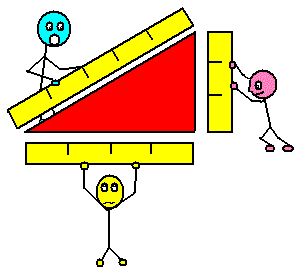| In physics, we often have to calculate distances to figure out how fast something is moving. If that speed is along a straight line, it's pretty easy, but once in a while we need to figure out the length of a diagonal. That's where the pythagorean theorem comes in. |
 |
| To use the pythagorean theorem, you need to know two sides of a right triangle. Then you can find the third side. The two short sides are known as A and B (it doesn't matter which is which) and the diagonal, the hypotenuse, is known by the letter C. Pythagoreas (an old dead Greek dude) figured out that if you squared side A, and squared side B, and added them together, you'd have side C squared. Nice trick, eh? |
| So let's put that mathematically. AxA + BxB = CxC or A2 + B2 = C2. Look at the picture at the right. You'll notice that the sides are lengths of 3, 4 and 5. 3x3=9... 4x4=16... 9+16 = 25! 5x5 = 25! Although not all right triangles are this neat, the ones in your assignment all work out nicely like this. |
Your assignment: On problems 1-5, figure out the missing side of the triangle using the information given. On problems 5 through 10, add the vectors.
-
1. You travel 12 miles west then 5 miles south. Find your distance from the origin. (Find C)
-
2. B=24 C=25. Find A
-
3. A=16 B=30. Find C
-
4. B=13 C=85. Find A
-
5. A=20 B=21. Find C.
-
6. add (2,6) (4,-1)
-
7. add (-4,2)(3,-2)
-
8. add (7,-2)(-3, 5)
-
9. add (2,2) (-19,-5)
-
10. add (3,-5) (-5,3)
|